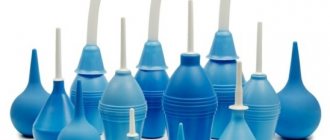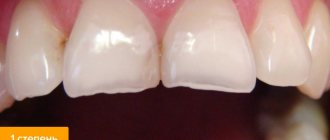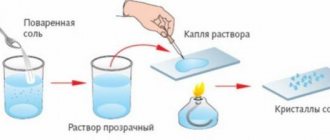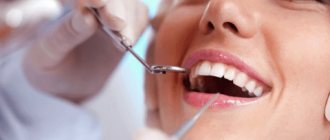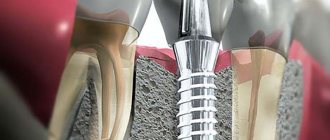What is Air Flow cleaning and how is it done?
Air Flow teeth cleaning is an effective dental procedure that allows you to remove bacterial and pigmented plaque, soft and hard deposits from the surface of your teeth. To achieve the desired result, a special device “Air Flow” (made in Sweden) is used, which gave the name to the procedure.
The Air Flow device creates a directed flow of air, water and fine abrasive particles. Applied to the surface of the teeth under high pressure, it delicately removes (cleanses) visible plaque and deposits from the surface of the teeth. As a rule, sodium bicarbonate is used as an abrasive - ordinary soda.
Teeth cleaning using the Air Flow system is carried out only in a dental setting and includes several stages.
- Treating lips with Vaseline.
- Position of the saliva ejector in the patient's mouth.
- The placement of a device in the mouth to collect excess flow of water, air and fine particles.
- Treatment of each tooth with a high-pressure stream at an angle of 30 - 600.
- Grinding of teeth using leveling paste.
- Treatment of teeth with a special fluoride-based gel to strengthen tooth enamel and reduce its sensitivity.
During treatment with a directed flow, special attention is paid to hard-to-reach places - interdental spaces, periodontal pockets. Unable to be cleaned during daily oral hygiene, they contain large amounts of plaque and deposits. But thanks to the penetrating power of Air Flow, they can be removed without much difficulty.
The total duration of the procedure is from 40 minutes to 1 hour, which depends on the condition of the teeth and the complexity of the problem.
Air Flow technology: key pros and cons of hardware sandblasting teeth cleaning
We are all familiar with the basic rules of oral hygiene: regular brushing of teeth twice every day, using dental floss, rinsing the mouth to remove food debris, systematically visiting the dentist's office for preventive examinations. But often this is not enough to provide reliable protection against caries and other dental pathologies. Professional teeth cleaning using the Air Flow system will help restore the natural whiteness of your smile and effectively remove dental plaque. Today we’ll talk in detail about what Air Flow cleaning is, how it’s done, what’s good about the technique and what its disadvantages are.
Cleaning with braces
Quite often, treatment with braces makes it difficult to thoroughly clean teeth. As a result, plaque and deposits can accumulate around orthodontic structures, for which the Air Flow system is ideal for removing. A targeted fine stream will gently clean the surface of the teeth and help maintain the necessary oral hygiene during orthodontic treatment.
The appearance of bacterial and pigment plaque, soft and dense deposits inevitably leads to the development of caries. Its progression provokes the appearance of such serious dental diseases as periodontitis and pulpitis - in this case, tooth loss is inevitable. Professional teeth cleaning using the modern Air Flow device helps stop the development of possible complications.
When is Air Flow cleaning indicated?
Air-Flow hygienic cleaning is an independent manipulation that is used to thoroughly remove plaque and soft dental deposits in order to avoid the development of carious and inflammatory processes. This is also a prerequisite for preparation for dental implantation, installation of crowns and dentures, and whitening using professional methods.
Thus, among the main indications for the use of Air-Flow technology, experts in the field of dentistry and hygiene identify the following phenomena and conditions:
- the formation of a dense layer of plaque on the teeth,
- change in enamel color,
- crowding of teeth, in which other methods of cleaning interdental spaces will be ineffective,
- recent completion of a course of orthodontic treatment using braces,
- upcoming professional whitening, implantation or prosthetics.
Plaque on teeth is an indication for using the method.
Experts say that this procedure should be done twice a year - the optimal frequency for maintaining the proper level of oral hygiene. Cleaning is especially recommended for smokers and coffee lovers.
Indications for the procedure
Professional oral hygiene using a sandblasting machine is recommended in the following cases:
- Visible darkening of the enamel color.
- The presence of pigment plaque and deposits on the surface of the teeth.
- Smoker's plaque
- Accumulation of plaque and deposits in the interdental space and periodontal pockets.
- The presence of braces, bridges and other dental structures that make hygienic cleaning of the oral cavity difficult.
- Upcoming procedure for dentures or teeth whitening.
Important to remember! The use of Air Flow is advisable for aesthetic, therapeutic and preventive purposes. Removing dental plaque will help restore your teeth to an attractive appearance and prevent the development of caries and serious dental diseases.
Contraindications
Removing plaque and deposits using the Air Flow device is considered a minimally invasive procedure that is well tolerated by the human body and does not harm its health. And only in rare cases is the procedure impossible. The following conditions and pathologies are such contraindications.
- The patient has not reached 15 years of age.
- Following a salt-free diet.
- Chronic respiratory diseases.
- Increased sensitivity of tooth enamel.
- Individual allergic reactions to the manipulations performed or the composition of the abrasive powder for cleaning.
- Pregnancy period.
Important to remember! Professional cleaning of the oral cavity with Air Flow is carried out only after prior consultation with a dentist. In case of chronic diseases, consultation with your doctor is necessary.
How painful is the procedure?
Comprehensive cleaning using the Air Flow system is carried out in the most comfortable environment for the patient. During the processing of enamel, some unpleasant sensations may occur, but no significant pain. To ensure the outflow of the sprayed product, a special suction is used, which, however, cannot guarantee 100% protection against contact of the composition with the mucous membrane of the mouth and pharynx. As a result, the patient may experience a slight burning sensation and dry soft tissues after the procedure. If you swallow too much of the cleanser, it can cause heartburn and indigestion.
How is Air Flow different from ultrasonic cleaning?
The effectiveness of the Air Flow technique is based on the abrasive properties of a fine flow that cleans the surface of the teeth. While the success of ultrasonic teeth cleaning is built on the ability of ultrasonic waves to destroy plaque, deposits and tartar due to a certain vibration frequency. Both methods are classified as mechanical teeth cleaning and are recommended for maintaining oral health.
In order to understand the difference between Air Flow and ultrasonic cleaning, let's look at the main advantages and disadvantages of these methods.
Benefits of Air Flow
- Minimally invasive.
- Removal of pigment, bacterial plaque and soft deposits.
- Ability to clean hard-to-reach places.
- Effective cleaning of teeth with braces, bridges and implants.
Flaws
- The method is not recommended for hypersensitive teeth.
- Air Flow will not remove tartar.
Benefits of ultrasonic cleaning
- Minimally invasive.
- Removal of pigment and bacterial plaque.
- Removal of soft and hard deposits.
- Tartar removal.
- Ability to clean hard-to-reach places.
Flaws
- The impossibility of using ultrasound in the presence of braces, implants and other dental structures.
Thus, Air Flow can be compared to “thorough cleaning”, and the use of ultrasound to “spring cleaning” in the oral cavity. Both methods differ not only in the method of exposure, but also in the depth of cleaning.
20% discount on prof. hygiene
Moscow
Air Flow - what is the essence of technology
The technology involves the use of a special Swiss-made Air Flow sandblasting machine. As part of the procedure, the enamel is treated with a special solution, which is supplied in the form of a jet under high pressure. The composition includes sodium bicarbonate mixed with oxygen. It is important to note that the solution does not damage the upper protective layer of the teeth.
So, the device itself provides two independent channels: the first provides the supply of abrasive powder mixed with water, while the second transmits a powerful air flow. Bacteria and tiny food debris literally peel off from the enamel. The doctor carefully treats each tooth, carefully removing pathogens even from the most inaccessible places, including periodontal pockets.
The products used during the procedure are also produced in Switzerland by EMS. Currently, formulations are available on the market, both neutral, that is, without any fragrances, and with various aromas. The first option is ideal for those patients who are prone to allergic reactions. In total, there are three variants of mixtures with different bases: classic, PERIO, SOFT1.
What's better?
Ideally, it is necessary to combine ultrasonic cleaning with the Air Flow procedure. The first will destroy hard deposits and tartar, which is especially important for hard-to-reach places, and the finely dispersed flow will delicately remove soft deposits and plaque.
Which is better is a difficult question. It all depends on the complexity of the problem, the individual characteristics of the enamel and the presence of contraindications. Therefore, an accurate answer can only be given after diagnosing the general condition of the oral cavity.
Note! The Air Flow procedure and ultrasonic cleaning are not teeth whitening. During these procedures, only slight whitening of the enamel is possible, by 1–2 tones, which is achieved by removing visible pigment plaque.
Air Flow during pregnancy
Pregnancy is a relative contraindication to the procedure. The problem is that during this period, calcium metabolism in a woman’s body is disrupted. As a result, tooth enamel loses its protective functions, becomes more sensitive, and brushing can cause it to thin out, which can trigger the development of dental diseases. Therefore, the Air Flow procedure is not recommended for pregnant women.
Recommendations after the procedure
For the first time after professional Air Flow cleaning, you should limit the consumption of excessively cold, hot, sweet, spicy and other irritating foods. In this case, the positive result achieved during the procedure will be noticeable immediately. To maintain it for a long time, you must adhere to the following recommendations.
- Use medicated toothpaste and a soft-bristled brush for daily oral hygiene.
- To thoroughly clean teeth and hard-to-reach places, regularly use rinses, flosses, and brushes.
- Repeat the procedure at least once a year.
In this case, it is necessary to regularly, once every 6 months, undergo a preventive examination by a dentist.
Recommendations after cleaning
When treating teeth with soda solution, teeth become sensitive. In order for the positive results of the Air Flow procedure to last as long as possible, doctors recommend following the following simple rules:
- after the manipulation, you should not eat food for two hours;
- afterwards you can eat soft foods so as not to injure your gums;
- Regular teeth brushing should be postponed for one day;
- for about 3 hours you should not smoke or drink drinks with dyes (coffee, tea, etc.);
- replace your old toothbrush with a new one.
To avoid bleeding gums, you can use a rinse based on chamomile or sage.
What's not allowed?
After thoroughly cleaning your teeth, you should reconsider your diet and bad habits. The following list should be banned.
- Eating excessively hard foods.
- Abuse of products with a high content of coloring substances (both natural and artificial).
- Eating foods high in acids.
- Tea, coffee, chocolate, red wine.
- Cigarettes.
If you don’t want to give up this list, then you need to be prepared for the fact that very soon a new pigmented plaque will form on the surface of the tooth enamel, and it will become more sensitive.
The first time after the procedure, there may be unpleasant painful symptoms, increased sensitivity of the teeth and slight bleeding of the gums. If you follow all the dentist’s recommendations, they disappear after 1 – 2 days.
Recommendations after treatment
The protective film on the enamel is restored in just a couple of hours, but until this happens, the patient needs to adhere to some simple rules. This is the only way the result will last as long as possible. Recommendations after brushing your teeth to remove tartar include giving up cigarettes and coffee for at least 2-3 hours. In the first couple of days, it is better to refrain from consuming the following drinks and foods:
- coffee drinks, juices with natural and artificial colors, red wine, strong black tea, colored sodas,
- berries, mustard and soy sauce, beets and other coloring foods.
After the procedure, it is advisable to stop drinking coffee.
As noted above, in the first couple of days the patient may experience increased sensitivity of the enamel, especially in relation to excessively hot and cold foods and drinks. The condition of dental tissues is normalized literally within 1-2 days.
Cost of the procedure
The average cost of the procedure is 5,000 rubles. The price of the service is determined based on the complexity of the problem with which the patient came to the dentist, the total volume of dental work and the price segment of the clinic. Quite often there are hot discounts on the Air Flow procedure.
Author: Elena Kopylova Dentist-therapist, endodontist. Work experience more than 8 years.
The information is for reference only. Before treatment, consultation with a doctor is necessary.

